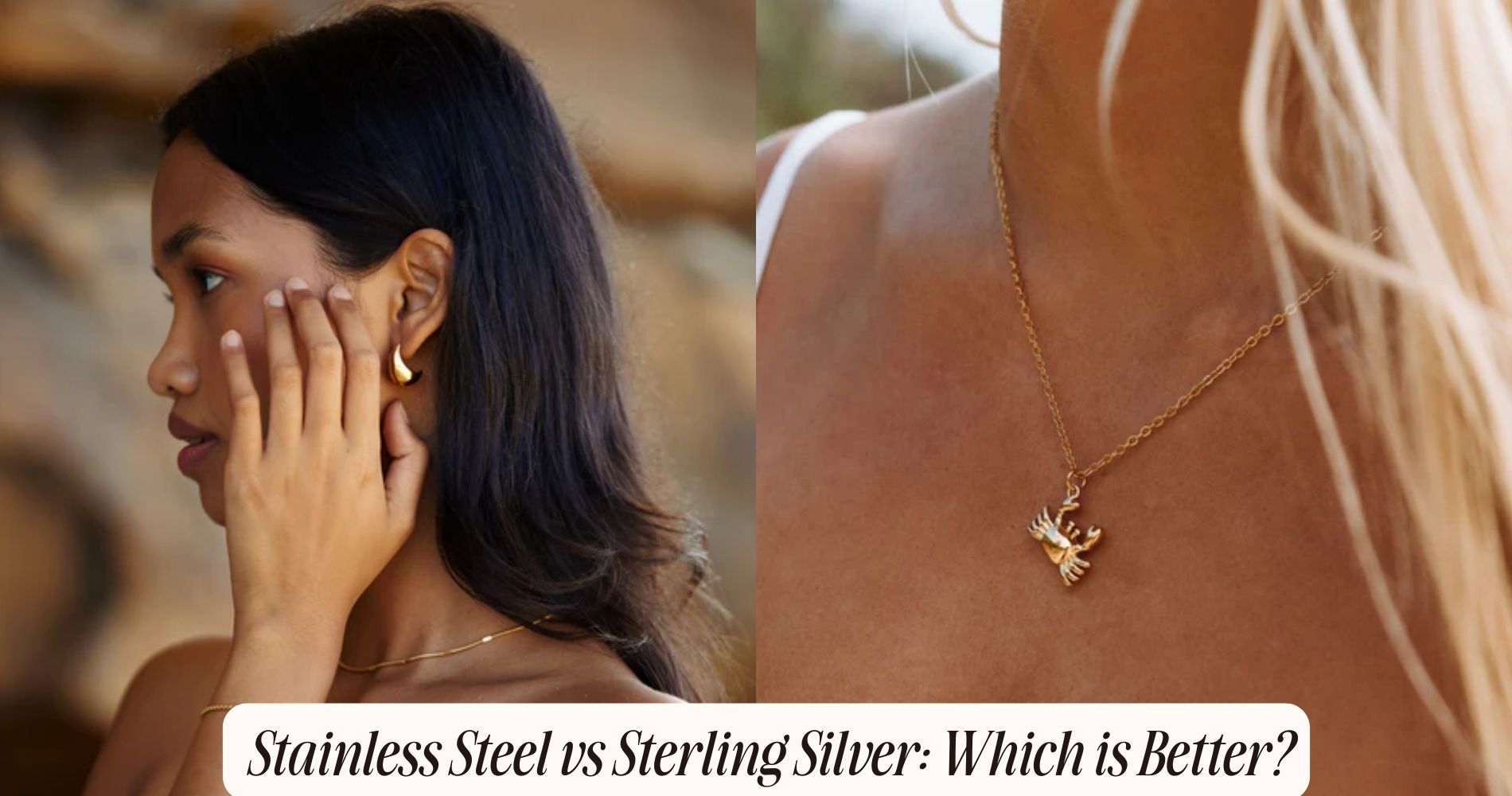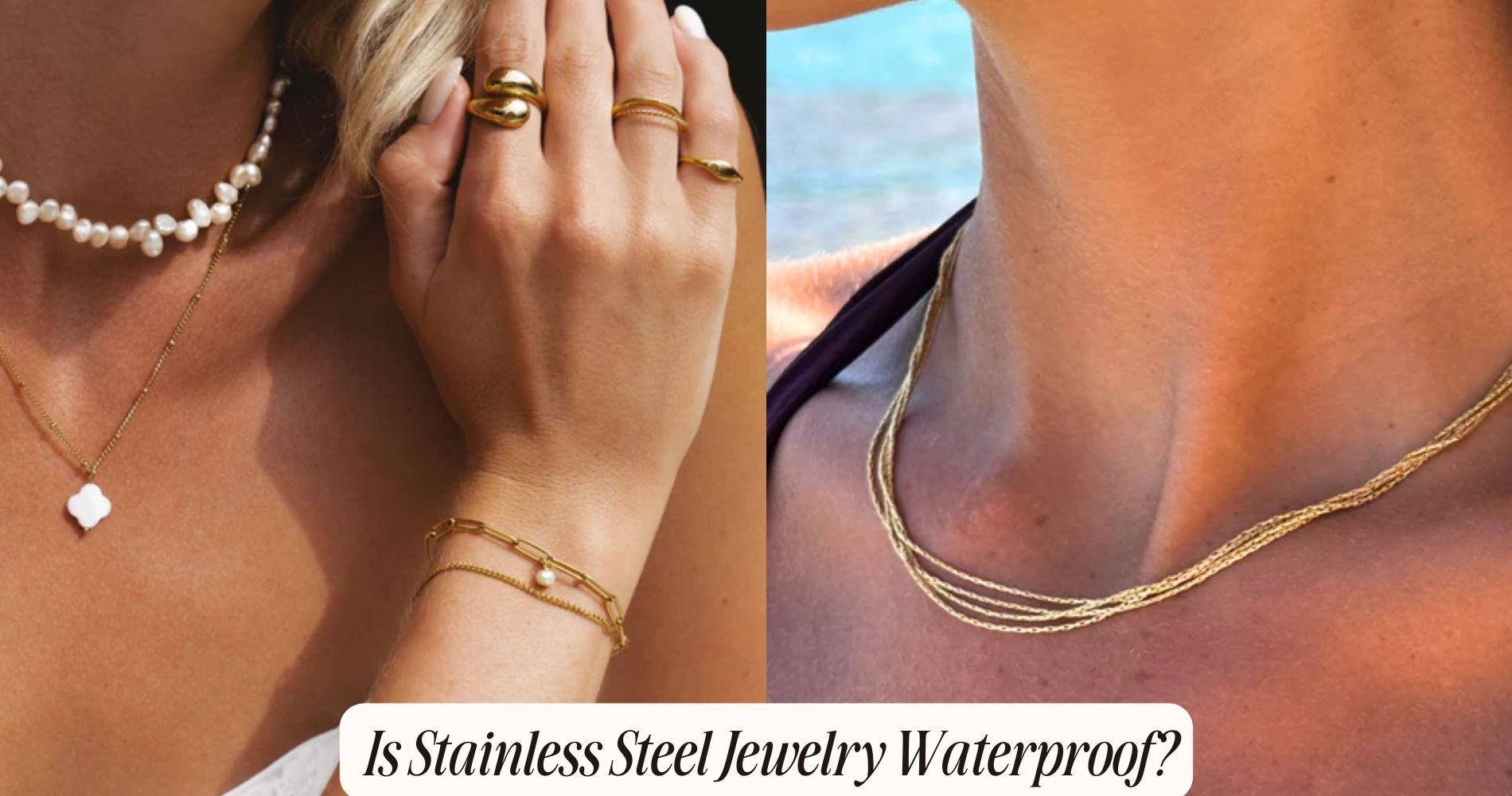
Stainless Steel vs Sterling Silver: Which is Better?
Cost Comparison
When evaluating the cost comparison between stainless steel and sterling silver, you'll find that stainless steel is generally more affordable due to its lower material and production costs. Stainless steel is composed mainly of iron, with chromium and nickel added for corrosion resistance, making it cost-effective to produce.
Sterling silver, on the other hand, consists of 92.5% pure silver and 7.5% other metals, typically copper, driving up both material and production expenses.
From a market trends perspective, stainless steel has gained popularity due to its affordability and versatility in various applications, such as jewelry, kitchenware, and industrial components. This increased demand has kept production costs relatively stable, further cementing its position as a budget-friendly option.
Sterling silver, while valued for its aesthetic appeal and higher intrinsic value due to its silver content, often commands higher prices, reflecting its status as a more premium material.
In terms of resale value, sterling silver generally offers better potential. Its intrinsic value tied to the fluctuating silver market can result in higher resale prices. Stainless steel, though durable, lacks this intrinsic value, making its resale market less lucrative.
Durability Factors
Due to its composition and material properties, stainless steel generally exhibits superior durability compared to sterling silver. Stainless steel, an alloy primarily composed of iron, chromium, and nickel, possesses excellent heat resistance, allowing it to withstand high temperatures without degrading its structural integrity. This makes stainless steel ideal for applications where thermal stability is critical.
In contrast, sterling silver, an alloy of 92.5% silver and 7.5% other metals (usually copper), has lower heat resistance, making it more susceptible to deformation under high temperatures. Additionally, stainless steel offers remarkable scratch resistance. Its dense molecular structure and the presence of chromium, which forms a protective oxide layer, contribute to its ability to resist abrasions and wear.
This scratch resistance ensures that stainless steel items maintain their aesthetic appeal and functionality over time, even with frequent use. Sterling silver, while aesthetically pleasing, is considerably softer and more prone to scratches and dents. This softness can lead to visible wear and tear, diminishing the material's appearance and structural reliability over time.
Maintenance Requirements
Both stainless steel and sterling silver require regular maintenance, but their differing material properties dictate distinct care routines.
Stainless steel, an alloy primarily composed of iron, chromium, and nickel, resists corrosion and tarnishing due to its chromium oxide layer. This means your polishing frequency is notably lower. Typically, a periodic wipe with a mild detergent and water suffices, making stainless steel an excellent choice for minimal upkeep.
Sterling silver, however, composed of 92.5% silver and 7.5% other metals, usually copper, is more prone to tarnish. Silver reacts with sulfur compounds in the air, forming a dark layer of tarnish. To prevent tarnish, you should store sterling silver in anti-tarnish cloths or airtight containers. Regular polishing with a specialized silver polish is necessary, and a higher polishing frequency is recommended to maintain its luster.
Aesthetic Differences
Stainless steel typically offers a sleek, modern look with a consistent, polished finish, while sterling silver often exudes a classic, timeless elegance with its lustrous sheen. When you compare the two, stainless steel's high chromium content provides a uniform, durable surface that maintains its appearance over time. This material's inherent tarnish resistance means you won't need to worry about frequent upkeep to preserve its polished finish.
On the other hand, sterling silver, composed of 92.5% silver and 7.5% other metals (usually copper), delivers a warm, radiant glow that's hard to match. However, it does lack the tarnish resistance of stainless steel. Over time, exposure to air and moisture can cause sterling silver to develop a patina, which some people find appealing as it adds character and depth to the piece.
The aesthetic differences ultimately come down to your personal preference. If you favor a contemporary, low-maintenance option with enduring brilliance, stainless steel is the way to go. But if you appreciate a traditional, luxurious look and don't mind occasional polishing to maintain that iconic shine, sterling silver might be more your style.
Hypoallergenic Properties
When considering hypoallergenic properties, you'll find stainless steel generally poses a lower nickel allergy risk compared to sterling silver. Sterling silver often contains copper or other metals that can be irritants for sensitive skin.
Analyzing skin sensitivity levels, stainless steel's composition typically results in fewer allergic reactions.
Nickel Allergy Risk
Nickel allergy risk is an important factor to take into account, as stainless steel often contains nickel, whereas sterling silver typically does not. Stainless steel's nickel content can range between 8-10.5%, making it a common culprit for triggering allergy symptoms in sensitive individuals. These symptoms can include redness, itching, and swelling at the point of contact. For those susceptible to nickel allergies, the presence of nickel in stainless steel can be a decisive factor against its use in jewelry or items with prolonged skin contact.
In contrast, sterling silver is composed of 92.5% pure silver and 7.5% other metals, typically copper. This composition minimizes the risk of nickel-induced allergic reactions. Sterling silver's hypoallergenic properties make it a preferred choice for people with nickel sensitivities. When you're evaluating materials for personal items, understanding the nickel content is essential.
If you experience allergy symptoms from nickel, opting for sterling silver over stainless steel can greatly reduce your risk. The analytical comparison between these materials highlights the need to take into account nickel content and potential allergic reactions before making a choice. For those with nickel allergies, sterling silver offers a safer, hypoallergenic alternative.
Skin Sensitivity Levels
Evaluating skin sensitivity levels is crucial when comparing the hypoallergenic properties of stainless steel and sterling silver. You need to take into account the likelihood of contact dermatitis and allergic reactions, especially if you have sensitive skin.
Stainless steel, particularly surgical-grade (316L), is renowned for its hypoallergenic properties. This grade contains minimal nickel, greatly reducing the risk of allergic reactions. For those prone to contact dermatitis, stainless steel offers a reliable option due to its inert nature and resistance to corrosion. Its biocompatibility makes it a preferred choice in medical applications, ensuring minimal irritation.
On the other hand, sterling silver consists of 92.5% pure silver and 7.5% other metals, often including copper. While silver itself is hypoallergenic, the presence of other metals can cause issues. Copper, for instance, can sometimes trigger contact dermatitis in sensitive individuals. Nevertheless, for many, sterling silver is well-tolerated and doesn't provoke allergic reactions.
Common Irritants Comparison
Understanding common irritants in stainless steel and sterling silver further clarifies their hypoallergenic properties and suitability for sensitive skin.
Stainless steel, particularly surgical-grade (316L), is renowned for its hypoallergenic properties. It contains minimal amounts of nickel and chromium, reducing the risk of allergic reactions to a considerable extent. When exposed to moisture, stainless steel resists tarnishing and corrosion, ensuring it doesn't trigger chemical reactions that could irritate your skin.
Sterling silver, on the other hand, consists of 92.5% silver and 7.5% other metals, usually copper. The presence of copper can sometimes cause allergic reactions, especially when combined with moisture exposure. Over time, moisture can accelerate tarnishing, resulting in a greenish or blackish layer that can irritate sensitive skin upon prolonged contact. Additionally, sterling silver's tendency to oxidize when exposed to air and sweat can lead to further chemical reactions that may not be suitable for those with metal sensitivities.
In analytical comparison, stainless steel's resistance to chemical reactions and moisture exposure makes it a more reliable choice for hypoallergenic jewelry.
Conversely, sterling silver's alloy composition and susceptibility to tarnishing under moisture exposure may render it less ideal for individuals with sensitive skin.
Versatility in Use
Stainless steel's high tensile strength and corrosion resistance make it ideal for industrial applications, while sterling silver's malleability and luster are perfect for intricate jewelry designs.
Stainless steel's robustness guarantees its widespread use in sectors like construction, automotive, and medical equipment. Its ability to withstand extreme temperatures and harsh environments provides unparalleled durability, making it a staple in industrial settings.
On the other hand, sterling silver's softer composition and reflective surface offer unmatched artistic versatility, aligning well with current fashion trends. Its ductility allows artisans to craft intricate and detailed designs, appealing to those seeking unique and personalized jewelry pieces.
Sterling silver's elegance and shine make it a preferred choice for high-end fashion accessories, where aesthetics play a critical role.
Comparatively, stainless steel's versatility extends beyond industrial use. It's also prominent in consumer products like kitchenware and fashion accessories, thanks to its strength and hypoallergenic properties.
Sterling silver, although less durable, offers greater flexibility with regards to design and customization, making it the material of choice for fine jewelry and decorative items.
Both materials serve distinct purposes based on their unique properties, catering to different industries and consumer needs.
Environmental Impact
When comparing the environmental impact of stainless steel and sterling silver, it's crucial to assess their entire lifecycle, from raw material extraction to end-of-life disposal.
Stainless steel production involves the extraction of iron ore, nickel, and chromium. These mining practices can lead to significant habitat destruction, water contamination, and greenhouse gas emissions. However, stainless steel has a high recycling rate, with approximately 80-90% of stainless steel products being recycled, which mitigates some of the environmental damage.
Sterling silver, on the other hand, usually comes from silver ore mining, which is also highly disruptive to ecosystems. The refining process involves toxic chemicals like cyanide, contributing to soil and water pollution. However, like stainless steel, sterling silver is highly recyclable. The recycling processes for silver are less energy-intensive compared to primary extraction, reducing overall environmental footprints.
Analyzing both materials, stainless steel's high recyclability and longer lifespan can offset its initial environmental costs more efficiently than sterling silver. Yet, sterling silver's lower energy requirement in recycling processes gives it a slight edge in certain contexts.
Ultimately, your decision should consider these factors to determine which material aligns better with your environmental values.
Frequently Asked Questions
How Do Stainless Steel and Sterling Silver Affect Magnetic Fields?
You'll find that stainless steel exhibits varying magnetic properties, often showing some magnetic susceptibility. Conversely, sterling silver has negligible magnetic susceptibility, making it practically non-magnetic and less reactive to magnetic fields.
Can Stainless Steel or Sterling Silver Be Used in Medical Implants?
You can use stainless steel in medical implants due to its corrosion resistance and strong biocompatibility factors. However, sterling silver isn't suitable because it lacks the necessary corrosion resistance and biocompatibility for safe, long-term use in the body.
What Are the Historical Uses of Stainless Steel and Sterling Silver?
You're exploring historical craftsmanship with stainless steel and sterling silver. Stainless steel, known for its corrosion resistance, emerged in the 20th century. Sterling silver, used in ancient artifacts, boasts conductivity and malleability, highlighting distinct material properties.
Are Stainless Steel or Sterling Silver Better for Conducting Electricity?
When comparing conductivity, sterling silver outperforms stainless steel. Its higher electrical efficiency makes it a better choice for applications requiring excellent conductivity. However, stainless steel's durability and resistance to corrosion might suit other use cases better.
How Do Stainless Steel and Sterling Silver Interact With Different Chemicals?
When considering tarnish resistance and corrosion behavior, stainless steel excels with superior resistance to most chemicals, while sterling silver is more prone to tarnishing and corrosion, especially with sulfur-containing compounds and acidic environments.
Conclusion
In weighing stainless steel against sterling silver, consider cost, durability, and maintenance.
Stainless steel is more affordable, extremely durable, and low-maintenance.
Sterling silver offers a classic aesthetic but requires regular upkeep to prevent tarnish.
Both are hypoallergenic, though stainless steel is less likely to cause reactions.
Versatility in use and environmental impact also favor stainless steel.
Ultimately, your choice hinges on balancing these material properties and your specific needs.
























Leave a comment
This site is protected by hCaptcha and the hCaptcha Privacy Policy and Terms of Service apply.